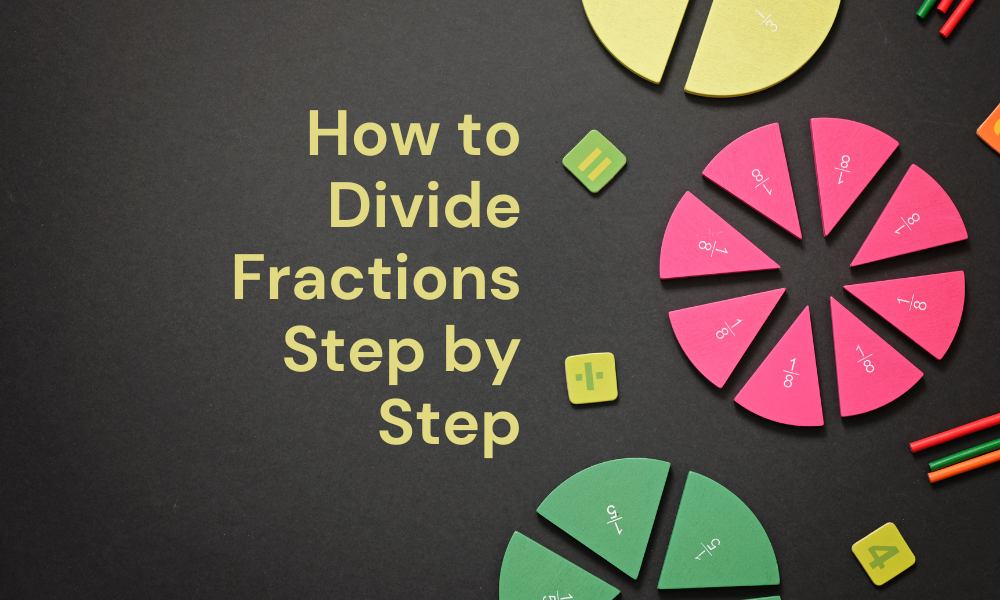
Dividing fractions is a fundamental skill in mathematics that is important for solving various math equations. Learn how to divide fractions step by step.
Understanding the basics
Before we dive into the steps for dividing fractions, let’s review some basic terms:
- Numerator: The top number in a fraction; it shows the number of parts we have.
- Denominator: The bottom number in a fraction; it shows the total number of equal parts.
For example, in the fraction 3⁄4, 3 is the numerator, and 4 is the denominator.
Six steps to divide fractions
Dividing fractions involves three main steps: invert, multiply, and simplify. Here’s how to do it:
- Invert the second fraction
- Multiply the fractions
- Simplify if needed
Example:
3⁄4 ÷ 2⁄5
1. Write down the fraction:
3⁄4 ÷ 2⁄5
2. Flip the second fraction; the first fraction stays the same:
The first step in dividing fractions is to invert the second fraction and keep the first fraction the same. We invert the fraction by swapping its numerator and denominator, meaning that what was the denominator before is now the numerator, and the numerator is now the denominator.
3⁄4 ÷ 5⁄2
3. Multiply the first fraction by the flipped fraction:
Change the division sign to a multiplication sign and multiply the first fraction by the inverted fraction.
3⁄4 × 5⁄2
4. Multiply the top numbers (numerators):
3 × 5 = 15
5. Multiply the bottom numbers (denominators):
4 × 2 = 8
Why do we use multiplication when we divide fractions?
Using multiplication when dividing fractions makes the process easier by changing the division problem into a multiplication problem with the inverted fraction. By converting division into multiplication, we can apply the more straightforward rules of multiplying fractions, which gives us accurate and simplified results.
6. Write your answer and simplify it if possible:
15⁄8
If possible, simplify the resulting fraction. Simplifying involves reducing the fraction to its lowest terms by finding the greatest common divisor of the numerator and the denominator. It also involves converting improper fractions to mixed numbers.
What is an improper fraction?
An improper fraction is a fraction where the numerator (the top number) is larger than or equal to the denominator (the bottom number). For example, 15⁄8 is an improper fraction because 15 is bigger than 8.
What is a mixed number?
A mixed number is a number that includes both a whole number and a fraction. For example, 2 5⁄7 is a mixed number, where 2 is the whole number and 5⁄7 is the fraction.
Steps to convert an improper fraction to a mixed number:
1. Divide the numerator by the denominator. Your answer will give you the whole number that will form part of the mixed number.
2. Find the remainder, which will become the fraction’s numerator (top number).
3. Write the remainder over the original denominator (bottom). This fraction, along with the whole number, forms the mixed number.
Since 15⁄8 is an improper fraction, we will change it to a mixed number. Our simplified answer is:
1 7⁄8
Common mistakes to avoid
- Forgetting to invert the second fraction: Always remember to invert the second fraction before multiplying. Remember that the first fraction stays the same.
- Forgetting to change the division sign to a multiplication sign.
- Incorrect multiplication: Ensure you multiply the numerators and denominators correctly.
- Not simplifying the fraction: Always check if your answer can be simplified further.
Conclusion
Dividing fractions may seem challenging and confusing at first, but by following these steps—keeping the first fraction the same, inverting the second fraction, changing the division sign to a multiplication sign, multiplying the numerators and denominators, and simplifying the final fraction if possible—you can tackle any fraction division problem with confidence. Practice with different sets of fractions to become more comfortable with the process. With these skills, you’ll be well-prepared to handle more complex mathematical concepts.
Edublox offers cognitive training and live online tutoring to students with dyslexia, dysgraphia, dyscalculia, and other learning disabilities. Our students are in the United States, Canada, Australia, and elsewhere. Book a free consultation to discuss your child’s learning needs.
Authored by Shanice Jordaan. Shanice holds a bachelor’s degree in education and has extensive teaching experience, having taught math for five years and English for three. She leverages her skills as an English teacher, online ESL teacher, and math and reading tutor to design engaging lessons, foster positive learning environments, and cater to diverse learning needs.


